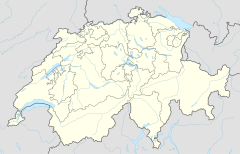Goetheanum
The Goetheanum, located in Dornach, in the canton of Solothurn, Switzerland, is the world center for the anthroposophical movement.
| Goetheanum | |
|---|---|
 | |
| General information | |
| Town or city | Dornach |
| Country | Switzerland |
| Coordinates | 47°29′10″N 7°37′13″E / 47.48611°N 7.62028°E |
The building was designed by Rudolf Steiner and named after Johann Wolfgang von Goethe. It includes two performance halls (1500 seats), gallery and lecture spaces, a library, a bookstore, and administrative spaces for the Anthroposophical Society; neighboring buildings house the society's research and educational facilities. Conferences focusing on themes of general interest or directed toward teachers, farmers, doctors, therapists, and other professionals are held at the center throughout the year.
The Goetheanum is open for visitors seven days a week and offers tours several times daily.
First Goetheanum

The First Goetheanum, a timber and concrete structure designed by Rudolf Steiner, was one of seventeen buildings Steiner designed between 1908 and 1925. It was intended as a Gesamtkunstwerk (the synthesis of diverse artistic media and sensory effects), infused with spiritual significance. Begun in 1913 to house the annual summer theater events of the Anthroposophical Society, it rapidly became the center of a small colony of spiritual seekers located in Dornach and based around Steiner. Numerous visual artists contributed to the building: architects created the unusual double-dome wooden structure over a curving concrete base, stained glass windows added color into the space, painters decorated the ceiling with motifs depicting the whole of human evolution, and sculptors carved huge column bases, capitals, and architraves with images of metamorphoses.
Already during the construction, musicians, actors, and movement artists began performing a wide variety of pieces in a neighboring workshop. When the Goetheanum hall was completed, in 1919, these performances moved onto the stage located under the Goetheanum's smaller cupola. The auditorium was located under the larger cupola. The building was opened on September 26, 1920.
This building was destroyed by fire on New Year's Eve, December 31, 1922 – January 1, 1923, and some claim by arson, but that is not proven.
Second Goetheanum






In the course of 1923, Steiner designed a building to replace the original. This building, now known as the Second Goetheanum, was built wholly of cast concrete. Begun in 1924, the building was not completed until 1928, after the architect's death. It represents a pioneering use of visible concrete in architecture and has been granted protected status as a Swiss national monument. Art critic Michael Brennan has called the building a "true masterpiece of 20th-century expressionist architecture".
The present Goetheanum houses a 1000-seat auditorium, now the center of an active artistic community incorporating performances of its in-house theater and eurythmy troupes as well as visiting performers from around the world. Full remodelings of the central auditorium took place in the mid-1950s and again in the late 1990s. The stained glass windows in the present building date from Steiner's time; the painted ceiling and sculptural columns are contemporary replications or reinterpretations of those in the First Goetheanum.
In a dedicated gallery, the building also houses a nine-meter-high wooden sculpture, The Representative of Humanity, by Edith Maryon and Rudolf Steiner.
Architectural principles
Steiner's architecture is characterized by a liberation from traditional architectural constraints, especially through the departure from the right-angle as a basis for the building plan. For the first Goetheanum he achieved this in wood by employing boat builders to construct its rounded forms; for the second Goetheanum by using concrete to achieve sculptural shapes on an architectural scale. The use of concrete to achieve organically expressive forms was an innovation for the times; in both buildings, Steiner sought to create forms that were spiritually expressive.
Steiner suggested that he had derived the sculptural forms of the first Goetheanum from spiritual inspirations.
Architects who have visited and praised the Goetheanum's architecture include Henry van de Velde, Frank Lloyd Wright, Hans Scharoun, and Frank Gehry.
Steiner designed approximately 12-13 other built structures, including both institutional structures and residences in and around Dornach.
References
External links

- Official website
- Goetheanum 3D VRML Models by Horst Kiechle
- The First Goetheanum at the Great buildings online website
- Architecture Section at the Rudolf Steiner Archive, An Online Library
- Architecture and Anthroposophy. (Arkhitektura i Antroposofiia. bilingual ed.) Anna Sokolina, ed., co-author. 1st and 2nd edition. 268p. M.: KMK Scientific Press. 2001, ISBN 5-87317-074-6. 2010, ISBN 5-87317-660-4. Official book website.
- Ákos Moravánszky, "The Rudolf Steiner Goetheanum: An architecture report from Dornach", Domus, February 2011
This article uses material from the Wikipedia English article Goetheanum, which is released under the Creative Commons Attribution-ShareAlike 3.0 license ("CC BY-SA 3.0"); additional terms may apply (view authors). Content is available under CC BY-SA 4.0 unless otherwise noted. Images, videos and audio are available under their respective licenses.
®Wikipedia is a registered trademark of the Wiki Foundation, Inc. Wiki English (DUHOCTRUNGQUOC.VN) is an independent company and has no affiliation with Wiki Foundation.
